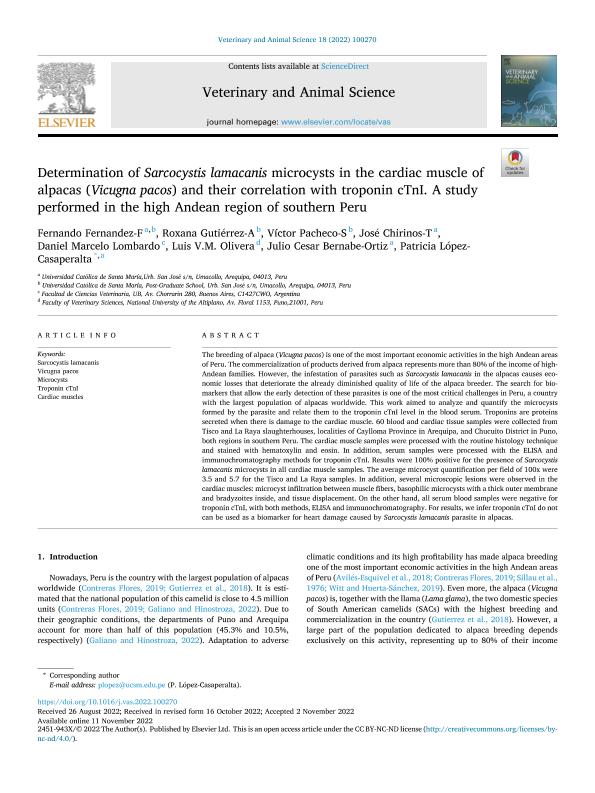Artículo
Determination of Sarcocystis lamacanis microcysts in the cardiac muscle of alpacas (Vicugna pacos) and their correlation with troponin cTnI. A study performed in the high Andean region of southern Peru
Fernandez F., Fernando; Gutiérrez A., Roxana; Pacheco S., Víctor; Chirinos T., José; Lombardo, Daniel Marcelo ; Olivera, Luis V. M.; Bernabe Ortiz, Julio Cesar; López Casaperalta, Patricia
; Olivera, Luis V. M.; Bernabe Ortiz, Julio Cesar; López Casaperalta, Patricia
 ; Olivera, Luis V. M.; Bernabe Ortiz, Julio Cesar; López Casaperalta, Patricia
; Olivera, Luis V. M.; Bernabe Ortiz, Julio Cesar; López Casaperalta, Patricia
Fecha de publicación:
12/2022
Editorial:
Elsevier
Revista:
Veterinary and Animal Science
e-ISSN:
2451-943X
Idioma:
Inglés
Tipo de recurso:
Artículo publicado
Clasificación temática:
Resumen
The breeding of alpaca (Vicugna pacos) is one of the most important economic activities in the high Andean areas of Peru. The commercialization of products derived from alpaca represents more than 80% of the income of high-Andean families. However, the infestation of parasites such as Sarcocystis lamacanis in the alpacas causes economic losses that deteriorate the already diminished quality of life of the alpaca breeder. The search for biomarkers that allow the early detection of these parasites is one of the most critical challenges in Peru, a country with the largest population of alpacas worldwide. This work aimed to analyze and quantify the microcysts formed by the parasite and relate them to the troponin cTnI level in the blood serum. Troponins are proteins secreted when there is damage to the cardiac muscle. 60 blood and cardiac tissue samples were collected from Tisco and La Raya slaughterhouses, localities of Caylloma Province in Arequipa, and Chucuito District in Puno, both regions in southern Peru. The cardiac muscle samples were processed with the routine histology technique and stained with hematoxylin and eosin. In addition, serum samples were processed with the ELISA and immunochromatography methods for troponin cTnI. Results were 100% positive for the presence of Sarcocystis lamacanis microcysts in all cardiac muscle samples. The average microcyst quantification per field of 100x were 3.5 and 5.7 for the Tisco and La Raya samples. In addition, several microscopic lesions were observed in the cardiac muscles: microcyst infiltration between muscle fibers, basophilic microcysts with a thick outer membrane and bradyzoites inside, and tissue displacement. On the other hand, all serum blood samples were negative for troponin cTnI, with both methods, ELISA and immunochromatography. For results, we infer troponin cTnI do not can be used as a biomarker for heart damage caused by Sarcocystis lamacanis parasite in alpacas.
Palabras clave:
CARDIAC MUSCLES
,
MICROCYSTS
,
SARCOCYSTIS LAMACANIS
,
TROPONIN CTNI
,
VICUGNA PACOS
Archivos asociados
Licencia
Identificadores
Colecciones
Articulos(OCA PQUE. CENTENARIO)
Articulos de OFICINA DE COORDINACION ADMINISTRATIVA PQUE. CENTENARIO
Articulos de OFICINA DE COORDINACION ADMINISTRATIVA PQUE. CENTENARIO
Citación
Fernandez F., Fernando; Gutiérrez A., Roxana; Pacheco S., Víctor; Chirinos T., José; Lombardo, Daniel Marcelo; et al.; Determination of Sarcocystis lamacanis microcysts in the cardiac muscle of alpacas (Vicugna pacos) and their correlation with troponin cTnI. A study performed in the high Andean region of southern Peru; Elsevier; Veterinary and Animal Science; 18; 12-2022; 1-7
Compartir
Altmétricas



